Rome Air Depot
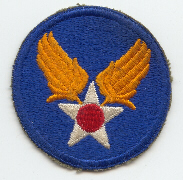
Griffiss Air Force Base was born out of the need for global defense. It all began back in 1941 when the Army Air Corps was looking for new locations to build air fields and repair depots. A list of possible locations was fabricated by the War Department and to the surprise of the citizens of upstate New York, Rome appeared on the list. Preliminary soil, water and ground testes were preformed on April 23rd. This put the local political machine into motion. Knowing the large amount of money and jobs that a possible air field would bring to Rome, the Common Council voted that the city would provide the use of up to one million gallons of water daily, housing for the workers, snow removal and sewage services. Passing the tests and the cooperation of the city officials led to a final decision favoring Rome. On May 1st, the War Department announced that Rome would become a new depot. The depot was to encompass over 2600 acres with a total price tag of over $13 Million Dollars.

On August 2, 1941, ground was officially broken for the Rome Army Air Depot. The mayor of the city, Huntington Etheridge, delivered a short but appropriate speech for the occasion. The highlight of his speech was summed up in one sentence, “This ground breaking ceremony is the most significant historical event which has happened within the city of Rome since that fateful day of August 3, 1777, when our flag was first raised in battle.” The laying in the concrete for the new runway was started on September 12th. Turner Mayersohn was the contracting company which was responsible for the building of the new depot. Despite the very cold and rainy weather, the runway was finished on October 14th. After the attack against Pearl Harbor on December 7th, at the request of the Secretary of War, the War Department ordered that construction be given top priority. In all, it took less than one year to complete. The Rome Air Depot was officially opened on February 1, 1942 and Colonel George McPike assumed command of the base along with an expected 7500 soldiers and workers.


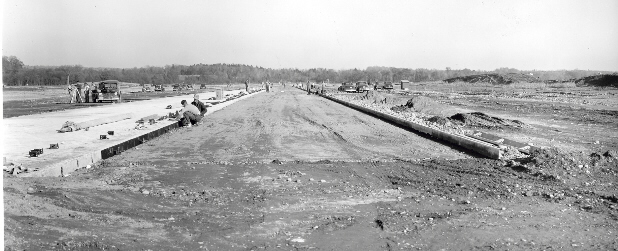
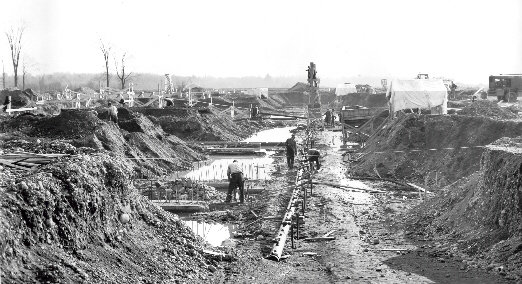
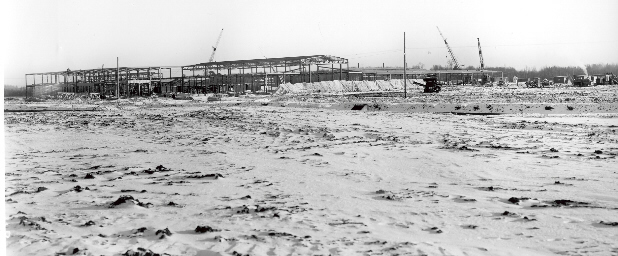
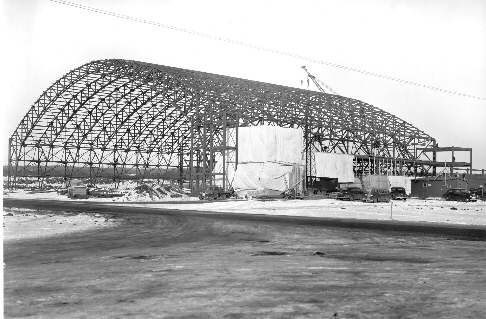

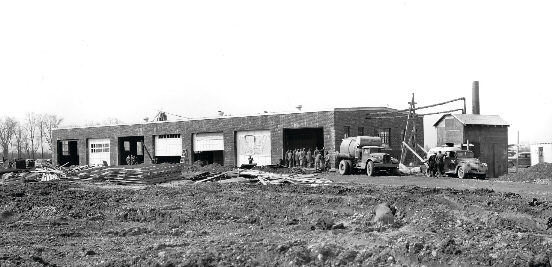
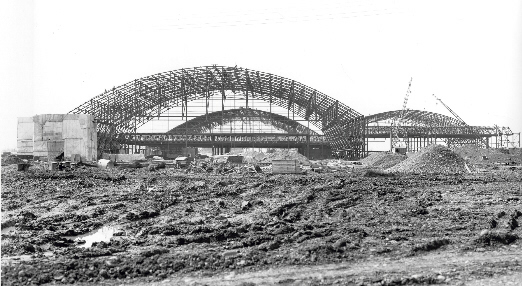
Construction of the Depot
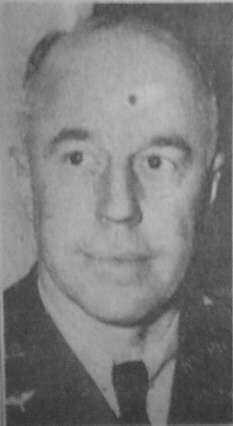
Colonel George McPike

Matchbook from the Rome Air Depot

Souvenir Pillowcase
The primary function of the Rome Air Depot or RAD, was that of maintenance, air craft storage and engine repair. One February 14th, the runway was officially opened. A few days later on the 18th, an A-17 piloted by Lieutenant Franklin Paul landed at the Rome Air Depot. On March 24th, the first contingent of 3500 troops began to arrive at the base. They already received extensive training at the State Fair Grounds in Syracuse from the Air Corps. On November 7th, an American Flag was formally raised in front of the entire depot, now at full troop strength. The temporary training and support offices in Utica and Syracuse were closed and relocated to the depot. Thus began a new era of defense in the Mohawk Valley. The 100th Aviation Squadron assumed the host mission of the base, and was under the Army Air Corps Material and Technical Services Command. Throughout World War II the name of the base was changed several times, but the mission never changed.
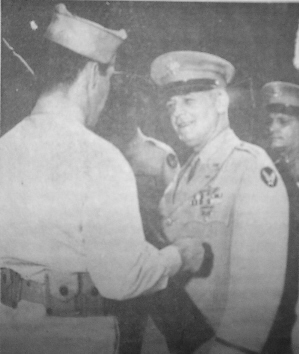
Visit of General Hap Arnold at the Depot
The war years were very eventful for the men and women stationed at the Rome Air Depot. Unfortunately, the wartime restrictions prevented most information of what happened from ever being published or talked about, so information on the early years is very vague. But the Rome Air Depot did establish itself as a pillar of the Rome community and never once failed to lend a helping hand to the city when needed. A conservative estimate of the time concluded that the Depot added about $10,000 a day to the local economy.

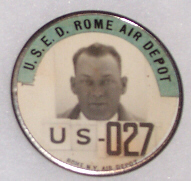
Workers photo badge from the Depot
With the large aerial battles waging in the skies over Europe and the Pacific, the Depot became a very busy place. Engines were repaired or reconditioned and shipped overseas to “Keep’em Flying.” In severe cases, the entire plane would be sent for repairs. One night while returning from a secret mission in Westover, Massachusetts, a transport plane carrying Colonel McPike and six other high officers from the Depot crashed. Colonle McPike escaped injury, however the others were killed in the crash. On February 18, 1943 a group of Airmen at the Depot broadcast a live Radio show through WIBX of Utica. The show became a success and a few weeks later they were able to share a live broadcast with actress Kate Smith. Colonel McPike was rotated overseas and was replaced on February 28, 1943 by General Charles Kane.

Program from the first Open House
On September 5th the first Open House was held for the people of upstate New York to view the new facilities and to learn what actually went on at the Depot. This was also an active way for the citizens to show support for the men and women in uniform. Thousands of visitors also had a chance to view a B-26 Bomber. This special bomber, nicknamed “Old Hellcat” saw 50 heavy combat missions over North Africa. The crew sank 5 ships, downed four ME-109 Fighter planes and dumped thousands of pounds of bombs on enemy positions. When the doors closed over 130,000 people visited the Open House.
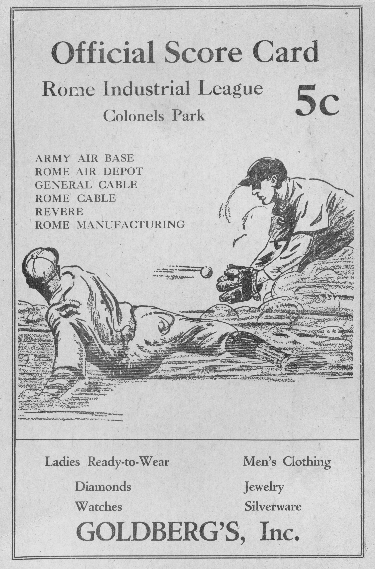
Baseball game program of base teams
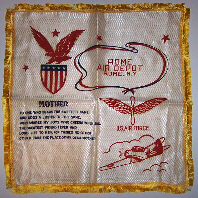
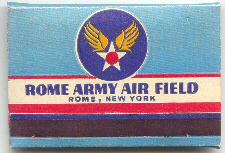


By 1944, over 19,000 were employed at the Depot, most being civilian employees. On February 6th, General Kane was rotated to Europe and Colonel A. W. Martenstein assumed command of the Depot. On July 12th a massive wind storm with tornado force winds wrecked havoc on the area including the depot. 72 planes and thousands of feet of storage feet were destroyed. Colonel Martenstein signed General Order #64 declaring the base in a state of emergency. It took several weeks to clean and repair the damage. 1944 was a bad year at the depot as several planes crashed. On August 6th, an F-8 fighter crashed killing both the Pilot and Co-Pilot. Weeks later an injured B-17 was making an emergency landing crashed on the runway seriously injuring the six crew members.
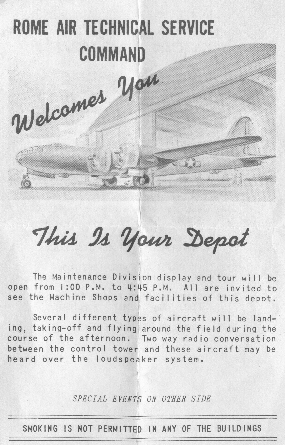
1945 brought the end of the War in Europe on May 8th and then the surrender in Japan on September 2nd. Work at the base continued to go on. The Depot shifted to a Peace time mission. Over the next two years the 4269th Army Air Force Separation Base Unit at Rome had to aid in the separation of Army Air Corps members from military service. When the unit was deactivated in 1947, they had processed over 13,000 airmen out of the service. The base was scheduled to be closed and all resources to be sold off by the end of 1947. Local Politicians fought a tough battle but they were able to keep the base from being closed. On August 23, 1947 the Department of Defense announced that the Rome Air Depot would remain with an active mission. Colonel Paul Burrows was assigned to be the next commander.

Aerial View of Griffiss Air Force Base
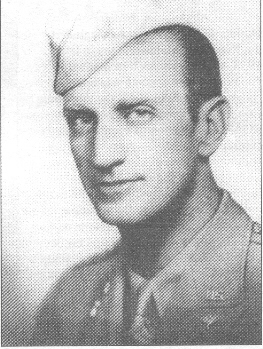
Lt. Colonel Townsend Griffiss
On September 20, 1948 Rome Air Depot was transferred from the Army to the Department of the Air Force and was commissioned as Griffiss Air Force Base. The base was named after Lt. Colonel Townsend Griffss, the first American Pilot to die in the Eastern Theatre of Operations during World War II. The Buffalo native, was shot down by members of the Royal Air Force when his plane was mistaken as an enemy fighter. The new Air Force Base fell under operational command of the Air Force Material Command.
Return Home
Next Page: Bombers
This page has been visited  times. times.
|